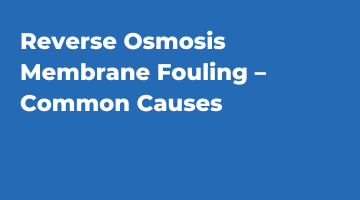Reverse Osmosis Membrane Fouling – Common Causes

When using a membrane-based water treatment system, fouling of membranes can create quite an issue for water operators. Reverse osmosis (RO), microfiltration (MF), nanofiltration (NF) and ultrafiltration (UF) are all membrane-based water treatment technologies and therefore are prone to fouling. Membrane fouling will at the very least decrease production and use more energy and can even lead to much more costly equipment replacements.
Membrane fouling occurs when contaminants are deposited on the surface of a filtration membrane, restricting the flow of liquids through the membrane’s pores. There can be one or more factors that contribute to fouling, such as the presence of excess biological, colloidal, and/or organic particles in the source water; an inappropriate choice of membrane material; and/or unsuitable process conditions such as flow rate, temperature, and pressure.
Common Causes for Membrane Fouling
- pH Extremes
- Oxidation
- Suspended Solids
- Scaling
- Organic
- Biological
- Temperature
Avoiding Membrane Fouling
Membrane fouling is sometimes reversible—but not always. That’s why it’s best to implement preventative measures to avoid or minimize membrane fouling in the first place. Below, are some common preventative measures to avoid membrane fouling.
Scheduled Cleaning
A systematic cleaning regimen can help to prevent foulants from building up on the membrane. Cleaning cycles should be scheduled monthly or at other regular intervals to provide the greatest benefit. Maintenance strategies can vary depending upon the membrane filtration system design and the types of contaminants involved, and can employ one or more cleaning methods, such as:
- Mechanical Cleaning involves the use of physical force to loosen contaminants from the membrane and flush them out of the system. Typical approaches include vibration, as well as backward or forward flushing, where water or a cleaning solution is run through the unit at a faster speed or higher pressure than in a normal service cycle, resulting in turbulence that removes foulants from the membrane.
- Chemical Cleaning involves the application of detergents, caustics, acids, antiscalants, or dispersants to loosen and remove foulants from the membrane surface. Cleaning chemicals are selected based on the type of contaminants present, with consideration also given to the membrane material to ensure that the chemicals used do not damage it.
System Design
Preventing membrane fouling is best accomplished by good planning and design. There are many variables that play a role in proper system function for a membrane filtration system, each of which should be considered when replacing a membrane or installing a new system. These include:
- Membrane material: Filtration membranes may be fabricated from a wide variety of synthetic polymers, ceramic, and metallic materials. Properties of the membrane material, such as its surface ionic charge, hydrophobicity, and pH tolerance range, determine whether the membrane will be resistant to certain types of fouling, and how well it will withstand process conditions and the necessary maintenance regimen.
- Membrane pore size: Pore size is the key factor to ensuring efficient removal of targeted contaminants by a membrane filtration unit. Additionally, selection of the proper membrane pore size can help to avoid fouling by optimizing permeate flux in light of other factors, such as feed water quality, temperature, and salt concentration.
- Operating conditions: Membrane fouling can be exacerbated by certain ranges of temperature, pH, transmembrane pressure, and flow rate. A well-designed system will balance these variables to ensure that foulants do not collect on the membrane surface.
Conclusion
Membrane fouling and scaling can be minimized by proper design and operating conditions. Important variables that control the membrane fouling must be considered in designing an operating the reverse osmosis system.
